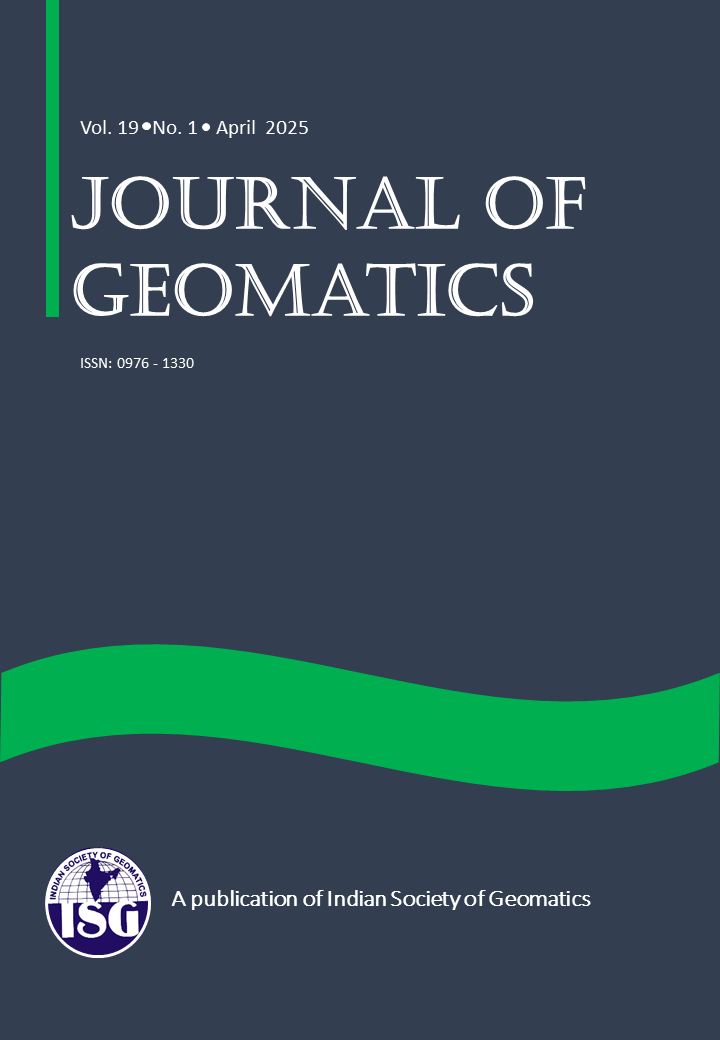Integration of Modern-Era Retrospective analysis for Research and Applications, Version 2 (MERRA-2) data and Lightning Detection Sensor (LDS) data for lightning event prediction
DOI:
https://doi.org/10.58825/jog.2025.19.1.183Keywords:
MERRA-2, Lightning Detection Sensor, Chi-squared test, ANOVA, Spearman-Rho, Extra Trees, bagging, Random Forest classifierAbstract
Lightning, a complex and potentially destructive atmospheric phenomenon, poses significant risks to public safety and infrastructure resilience globally. In India, the frequency of lightning strikes, particularly during the monsoon season, underscores the importance of early warning systems. The development of accurate detection and timely warning infrastructures is essential to mitigate the impact of lightning events and enhance disaster preparedness. At present 46 lightning detection sensors (LDS) are installed across India, by the Indian Space Research Organisation (ISRO). Each LDS is having 300 Km range detection. The network is designed with a 50% overlap to ensure high geolocation accuracy and maintain redundancy in regions with a strong LDS presence. Though this study is focused on a region with a strong existing LDS network, we recognized that there are regions throughout the nation where the LDS network is weak or nonexistent moreover LDS focuses on detection rather than prediction. To address this disparity, the study has two primary objectives: first, to advance beyond detection by developing models that can predict lightning events before they occur; and second, to enhance lightning detection capabilities in areas where the LDS network is sparse or nonexistent. This research relies on data from the Modern-Era Retrospective Analysis for Research and Applications, Version 2 (MERRA-2) dataset and the LDS dataset, focusing on the region between 86.68°E to 88.52°E longitude and 24.70°N to 26.42°N latitude during June 2022. To improve grid and temporal resolution, data refinement techniques were applied. Following this, statistical analyses, including the Chi-squared test, ANOVA, and Spearman-Rho correlation, were conducted to identify the parameters most strongly correlated with lightning occurrences. Humidity, pressure, and precipitation emerged as the most predictive factors.
Using these parameters, the Extra Trees model with bagging was employed to predict lightning occurrences, and a Random Forest classifier was used to predict lightning intensity based on the number of strikes. These models were validated using additional datasets. The findings from this study have the potential to significantly advance early warning systems, particularly in regions with limited LDS coverage, thereby enhancing resilience to natural hazards such as lightning across a wider area.
References
(Biswas, P. 2024, January 18). Bolt From The Blue: Lightning accounts for the highest number of ‘force of nature’ deaths in the country. Retrieved from The Indian Express: https://indianexpress.com/article/cities/pune/lightning-deaths-india-9115129/
Degala, V., Taori, A., & Suryavanshi, A. S. (2020, October 15). Lightning Essential Climate Variables. NRSC- Lightning Detection Sensor Network: Time of Arrival (TOA) method based Geo-location and Essential Climate Variable Generation. Hyderabad, India. Retrieved from bhuvan Indian Geo-Platform of ISRO: https://bhuvan-app1.nrsc.gov.in/lightning/nrsc_tech.pdf
(GMAO), G. M. 2015). inst3_3d_asm_Cp: MERRA-2 3D IAU State, Meteorology Instantaneous 3-hourly (p-coord, 0.625x0.5L42). Modern-Era Retrospective analysis for Research and Applications, Version 2. Greenbelt: Goddard Space Flight Center Distributed Active Archive Center (GSFC DAAC). doi:10.5067/VJAFPLI1CSIV
Shankar, A., Kumar, A., & Sinha, A. (2024). Incident of lightning-related casualties in Bihar, India: An analysis and vulnerability assessment. J Earth Syst Sci, 133(73 ). doi:10.1007/s12040-024-02277-4
Paul, A., & Maity, R. (2023). Future projection of climate extremes across contiguous northeast India and Bangladesh. Scientific Reports, 13(15616 ). doi:10.1038/s41598-023-42360-2
Mondal, U., Sreelekshmi, S., Panda, S., Kumar, A., Das, S., & Sharma, D. (2023). Diurnal variations in lightning over India and three lightning hotspots: A climatological study. Journal of Atmospheric and Solar-Terrestrial Physics, 252. doi:10.1016/j.jastp.2023.106149
Sattar, A., Khan, S., & Banerjee, S. (2021). Climatic water balance for assessment of growing season in the eastern Indian state of Bihar. MAUSAM, 70(3), 569-580. doi:10.54302/mausam.v70i3.269
Singhal, R., & Rana, R. (2015). Chi-square test and its application in hypothesis testing. Journal of the Practice of Cardiovascular Sciences, 1. doi:10.4103/2395-5414.157577
Zhang, H., Deng, Y., Wang, Y., Lan, L., Wen, X., Fang, C., & Xu, J. (2024). Extraction of factors strongly correlated with lightning activity based on remote sensing information. Remote Sensing, 16(11), 1921. https://doi.org/10.3390/rs16111921
Ali, M. (2020, April). PyCaret: An open source, low-code machine learning library in Python (Version 1.0.0). PyCaret. https://www.pycaret.org
Abdelkader, B., Jaziri, R., & Bernard, G. (2019). Deep extremely randomized trees. In Advances in Data Science and Artificial Intelligence (pp. 843-850). Springer. https://doi.org/10.1007/978-3-030-36708-4_59
(Rocca, J. 2019, April 23). Ensemble methods: bagging, boosting and stacking . Retrieved from Medium: Ensemble methods: bagging, boosting and stacking | by Joseph Rocca | Towards Data Science
Akhter, J., Roy, S., & Midya, S. K. (2024). Assessment of lightning climatology and trends over eastern India and its association with AOD and other meteorological parameters. Journal of Earth System Science, 133(36). https://doi.org/10.1007/s12040-023-02246-3 2021
Han, Y., Luo, H., Wu, Y., et al. (2021). Cloud ice fraction governs lightning rate at a global scale. Communications Earth & Environment, 2, 157. https://doi.org/10.1038/s43247-021-00233-4
Chakraborty, R., Chakraborty, A., Basha, G., & Ratnam, M. V. (2021). Lightning occurrences and intensity over the Indian region: Long-term trends and future projections. Atmospheric Chemistry and Physics, 21, 11161–11177. https://doi.org/10.5194/acp-21-11161-2021
Downloads
Published
How to Cite
Issue
Section
License
Copyright (c) 2025 Journal of Geomatics

This work is licensed under a Creative Commons Attribution-NonCommercial 4.0 International License.



